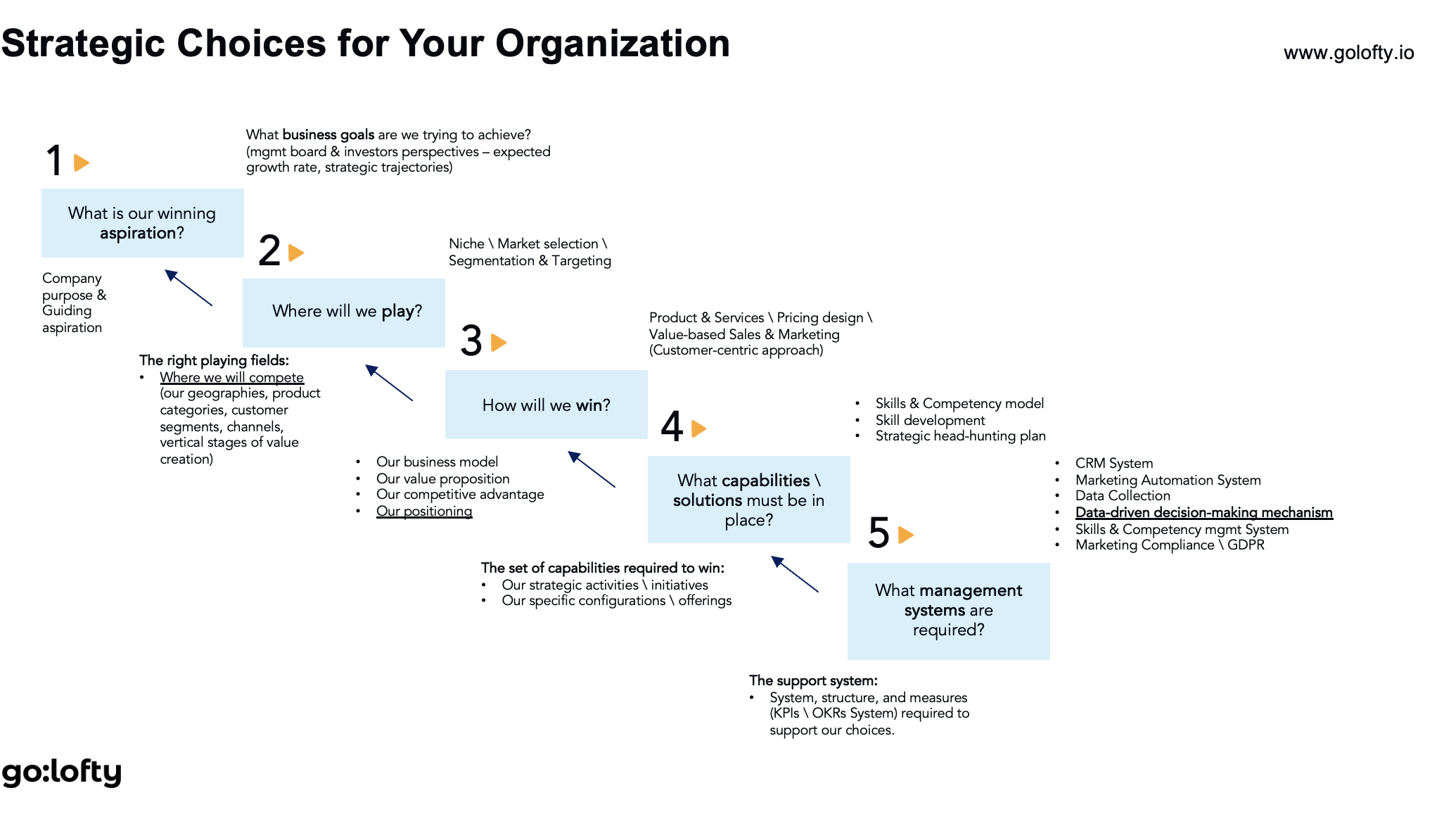
What Makes a Strategic Framework Essential for Modern Leaders?
Organizations rarely fail because they lack ambition. They fail because their ambitions never crystallize into choices that can be executed across departments. A strategic framework addresses this gap. It provides a disciplined way to define purpose, choose markets, design competitive advantage, and install the systems that ensure delivery.
For executives, the framework is more than a planning tool. It is the operating system of strategy. It ensures that every initiative—whether a digital transformation, a product launch, or a market expansion—flows logically from the same foundation. Without this coherence, strategy collapses into a patchwork of projects with little cumulative effect.
How Do You Define a Winning Aspiration?
Every framework begins with aspiration. This is not a financial forecast or a vague vision statement. It is the organization’s higher-order definition of success. The aspiration answers the question: What are we ultimately trying to achieve?
For some, the aspiration is market leadership in a defined category. For others, it is reshaping an industry or driving societal change. Tesla’s mission to “accelerate the world’s transition to sustainable energy” is a classic example. It guides every product decision, partnership, and investment choice.
Executives should ensure that aspirations are ambitious but also anchored in reality. An aspiration too narrow will fail to inspire; one too broad will fail to guide decisions. The right aspiration becomes both a north star and a filter for what matters most.
Where Should We Choose to Compete?
Once aspiration is clear, the next challenge is focus. No organization can compete everywhere. Leaders must define where to play: geographies, customer segments, product categories, and stages of the value chain.
This choice is often the most difficult because it requires saying no. Yet without boundaries, organizations spread themselves thin and lose advantage. Spotify, for example, began by playing in digital streaming for digitally native consumers, resisting the temptation to compete in physical distribution. That narrow decision created scale and credibility, which later enabled global expansion.
The discipline of “where to play” ensures resources are directed to markets where the organization can truly differentiate.
How Will We Win in the Markets We Enter?
Participation is not enough; leaders must define how to win. This means articulating why customers, clients, or partners will choose your offering over alternatives.
Winning is about a distinctive value proposition supported by a credible business model. IKEA, for example, won not just on low cost but on the integration of affordable design, flat-pack logistics, and an in-store experience that turned furniture shopping into an outing.
Executives must translate intent into a proposition that resonates. Without this clarity, organizations may find themselves active in attractive markets but with no clear edge.
What Capabilities Must Be Built to Deliver Strategy?
No strategy succeeds on ambition alone. Execution depends on capabilities—the organizational muscles that bring choices to life.
These capabilities are unique to each strategy. A pharmaceutical company may need clinical trial management and regulatory affairs expertise. A SaaS business may need product-led growth capabilities and rapid software deployment. Apple’s design and ecosystem integration are not generic strengths; they are tailored to its chosen way of winning.
Leaders should invest disproportionately in the few capabilities that make their “how to win” real. Building everything is impossible; building the right things is decisive.
Which Management Systems Sustain Strategic Alignment?
Even with aspirations, choices, and capabilities defined, strategy will fail without systems to sustain alignment. Management systems are the mechanisms that measure performance, reinforce priorities, and enable adaptation.
Balanced scorecards, OKRs, CRM platforms, marketing automation, and compliance programs are not simply tools; they are the infrastructure that keeps strategy on track. A defense contractor, for example, cannot credibly execute without rigorous compliance systems. A digital-first company cannot scale without analytics to inform decisions in real time.
The strength of a system is not in the software but in its ability to make choices visible and enforce discipline across the enterprise.
A Practical Overview of the Strategic Choices Model
The scheme above illustrates the framework as a clear five-step process. It asks executives to move systematically from aspiration to execution, ensuring each decision reinforces the next.
Winning Aspiration – Define the company’s purpose and guiding goals. Align ambition with board and investor expectations for growth and trajectory.
Where to Play – Identify the playing fields: geographies, product categories, customer segments, channels, and vertical stages of value creation. Choose the niches and markets where the company has the greatest opportunity.
How to Win – Articulate the business model, value proposition, competitive advantage, and positioning. Connect offerings and pricing design to customer-centric sales and marketing approaches.
Capabilities to Win – Build the skills and resources required: strategic initiatives, specialized competencies, recruitment and development plans, and offerings configured to fit the strategy.
Management Systems – Establish the support infrastructure: CRM, marketing automation, data analytics, decision-making mechanisms, skills management, and compliance systems such as GDPR. These systems ensure choices are executed consistently and measured effectively.
Together, these five questions provide an integrated framework. The power of the model is that it is both comprehensive and adaptable, guiding organizations to make deliberate choices while allowing space for iteration as conditions change.
Why a Framework Future-Proofs the Organization
Markets are not static. Competitors move, regulations shift, and technologies disrupt. A rigid strategy risks obsolescence; a well-designed framework creates resilience. Netflix began with DVDs, then shifted its “where to play” to streaming, and later into original content. The aspiration remained the same—entertainment for global audiences—but the choices evolved.
The true test of a framework is whether it can absorb shocks and redirect the organization without losing coherence. For leaders, this adaptability is the difference between a strategy that lasts and one that fades.
Closing Thought: Strategy as a Living System
Strategy is not a document. It is a set of living choices that must be translated into action every day. A framework provides the architecture for those choices—clear aspirations, deliberate focus, competitive logic, capabilities, and systems.
For executives, the imperative is clear: treat strategy as a function, not an event. With a robust framework, organizations can compete with confidence today and adapt with resilience tomorrow.
Go:lofty bonus content
1. What is a strategic framework, and why should my company use one?
A strategic framework is not a plan; it is the structured logic that connects vision to execution. It defines the choices a company makes about where to compete, how to win, and how to measure success. Without a framework, strategy risks becoming a collection of disconnected initiatives. With one, leaders ensure that every decision, investment, and priority reinforces the same direction.
2. How do I choose the right strategic framework for my organization?
There is no universal model. A multinational may use the Balanced Scorecard to align complex functions, while a startup may favor a Lean Canvas to test assumptions quickly. The right framework depends on your stage of growth, complexity of operations, and strategic horizon. The principle is less about adopting one model and more about selecting a structure that fits your decision-making reality.
3. How do frameworks help with execution, not just planning?
Execution falters when teams lack clarity on priorities and trade-offs. A framework provides a translation mechanism: it takes corporate-level intent and cascades it into departmental and individual objectives. This reduces misalignment, prevents duplication of effort, and ensures that execution is measurable and coherent. In other words, frameworks make strategy operational.
4. Can frameworks adapt in fast-changing markets?
Yes — if designed correctly. Rigid frameworks create fragility; adaptive ones create resilience. The best frameworks include feedback loops where market signals, competitor moves, and performance data feed back into the next cycle of strategic choices. This transforms strategy from a static roadmap into a living system of learning and recalibration.
5. How do I avoid overwhelming my teams with too many KPIs or priorities?
The most effective frameworks emphasize the critical few over the trivial many. Research shows that organizations executing against three to five priorities outperform those pursuing ten or more. The role of leadership is to make trade-offs explicit: deciding what not to do is as important as setting ambitious goals.
6. How do frameworks align cross-functional teams?
Departments often optimize for local metrics, creating silos. A good framework defines outcomes that cut across boundaries — customer retention, innovation speed, cost-to-serve — and links them to departmental contributions. This makes alignment measurable and forces collaboration. In effect, the framework becomes a shared language that reconciles competing interests.
7. How can I use a strategic framework to secure executive or board buy-in?
Boards and senior executives want clarity and confidence. A framework provides both. It shows how individual projects roll up into enterprise value creation, how risks are being managed, and how success will be measured. Instead of presenting fragmented initiatives, you present an integrated system. This reduces uncertainty and strengthens the case for investment.
8. How do I know if my current framework is failing?
Warning signs include:
Strategy reviews that devolve into budget debates.
Conflicting KPIs across departments.
Execution delays with no clear accountability.
Frequent pivots without learning.
If these symptoms appear, the issue is not execution discipline alone but a weak underlying framework that fails to provide alignment and focus.
9. How do AI and digital tools enhance strategic frameworks?
AI transforms frameworks from static charts into dynamic systems. Modern platforms can automate intelligence gathering, run scenario models, and monitor execution in real time. This allows leaders to validate assumptions faster, test financial outcomes before committing, and spot risks early. In short, AI turns strategic frameworks into decision engines.
10. What is the ROI of using a strategic framework?
The return comes in three forms:
Efficiency — fewer wasted initiatives and faster resource allocation.
Effectiveness — higher success rates of projects aligned with strategy.
Adaptability — the ability to pivot quickly without losing coherence.
Companies that systematize their strategic frameworks typically see measurable improvements in revenue growth, EBITDA margins, and organizational agility. In McKinsey studies, alignment through frameworks has correlated with up to a 30% improvement in execution outcomes.




